- Home
- Encyclopedia
- Touring Wyoming “Awheel”: Boneshakers To Bicycl...
Touring Wyoming “Awheel”: Boneshakers to Bicycles Built for Two
Longtime land surveyor Billy Owen of Laramie, Wyo., toured Yellowstone National Park on his Columbia high-wheel in 1883. He and his bicycling comrades became the first people to ride through Yellowstone and the first to “cross the Continental Divide awheel.”
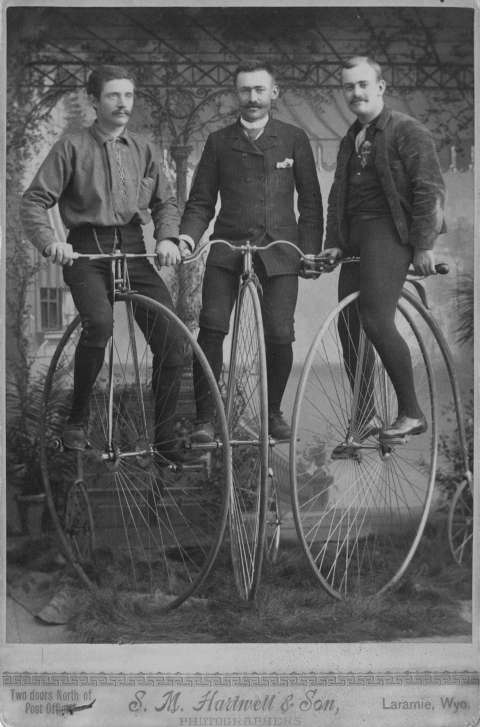
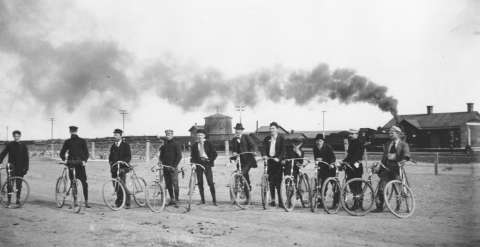
His thrilling descriptions of the trip, published in the June 1891 issue of the sports magazine Outing, included one about a hard climb followed by a steep descent: “By severe pedaling the top was reached, when, throwing legs over handles, we began our first coast and flew down the mountain with the speed of the wind.”
The “handles” were the mustache-shaped handlebars of the high-wheels. Owen, for whom Mount Owen in the Grand Tetons was later named, was known by family and friends as a vivid storyteller—sometimes an exaggerator—and he held nothing back in this account.
Because the cyclists rapidly approached a group of American Indians and did not know if they were “peaceable or on the warpath,” he wrote, “it was deemed best to make a rush and frighten them” before the Indians realized what was happening.
“Accordingly,” Owen wrote, “we released our wheels from the brake and gave them entire freedom down this slope, which certainly has a fall of 400 feet to the mile. … In my heart I believe that no men ever moved with greater velocity on a wheel than did we on this occasion.”
The Indians supposedly scattered and the Owen contingent made it safely down the hill without crashing. The high-wheels, successors of earlier cycles known as velocipedes, were sometimes called penny-farthings because they resembled the large and small British coins of the same name. Their tires were hard rubber. Special mounting boxes were needed for riders to climb onto the seats of the taller wheels.
Some early day bicyclists, who were perhaps less agile than Owen, took spills called headers—a common type of accident—when they hit a bump or lost their balance and the wheels went end over end, tossing the rider onto the ground and making obvious why earlier bicycle models were also known as boneshakers. Cyclists learned to put their legs over the handlebars, as Owen described, to attempt to land feet first rather than head first in the event of a crash.
Despite such risks, the activity gained popularity throughout the country. A recent article published in Bicycling magazine estimated about 50,000 riders in the United States in the 1880s, and explained that by the mid-1890s, a million bicycles a year were being produced in the nation. By that time modern-looking “safety” bicycles as they were called, with two wheels of the same size and inflatable tires, were coming into wide use.
Wyoming riders formed bicycle clubs in several cities. The Cheyenne Bicycle Club began in 1892. According to a later report in the Wyoming Eagle, its 60 members included many prominent Cheyenne men, from bookkeepers and bankers to attorneys, physicians, merchants and harness makers. They “wore uniforms composed of jackets, knee breeches, and tight-fitting caps.” The group competed with another Cheyenne club, the Knickerbocker Club, as well as other Wyoming clubs and some in Colorado. Billy Owen was a member and officer of the Laramie Athletic Club, and in Rawlins, Dr. Lillian Heath, the state’s first female physician, became the first woman member of the Rawlins Bicycle Club.
In 1893, the Cheyenne Daily Sun gave the prize list for the upcoming Fourth of July races. Races of various lengths were open to all Wyoming riders. For some races, gold medals ranging in value from $20 to $60 were offered. For the five-mile race, though, first prize was a Fowler wheel—a bicycle—valued at $160 and second prize was $2,000 worth of accident insurance for one year. The “last man over the tape” received a hay bale.
The Cheyenne Daily Sun hints at the bicycle craze in Wyoming in an item in its June 18, 1894, issue. Prizes for a raffle held at the Tivoli were a saddle horse and a Columbia bicycle.
The Great Transcontinental Relay Race
In 1896, members of the groups and riders from each of the towns participated in the New York Journal-San Francisco Examiner Great Transcontinental Relay Race, the brainchild of William Randolph Hearst, who published both newspapers, and bicycle manufacturer E.C. Stearns. Wheelmen carried a packet of papers from the West Coast to the East Coast. Teams of racers riding day and night covered the 3,500 miles in 13 days and 29 minutes, from August 25 to September 7.
Charles “Bug” Erswell, a Cheyenne Bicycle Club member, supervised the third district, the 635-mile portion from Rock Springs, Wyo., to Kearney, Neb. By this time, bicycles more closely resembled modern ones, with two wheels of similar size. Erswell, who reportedly had once set a record for a three-mile run when he attached a sail to his bicycle and used a brisk wind to push him to a speed of about 60 miles per hour, chose riders from his club for the relay, including Charles Bristol and L. L. Dietrich, as well as others like Elmer Lovejoy, the early day Laramie carmaker. The New York Journal reported a Denver woman, identified as Mrs. Rhinehart, “will ride nine miles up the west slope of Sherman Hill at a grade of 100 feet to the mile.” She “has ridden 200 miles in seventeen hours,” the article stated.
Dignitaries along the way signed the messages included in the packet. In Cheyenne, Alice Richards served as “acting governor” for the event during the absence of her father, Gov. W.A. Richards, from the state. Johnny Green, the rider who arrived in Cheyenne to present her with the papers, hit a mud puddle, took a spill and landed on his hands and knees at her feet. One newspaper report described her as “signing with an air of pretty embarrassment.”
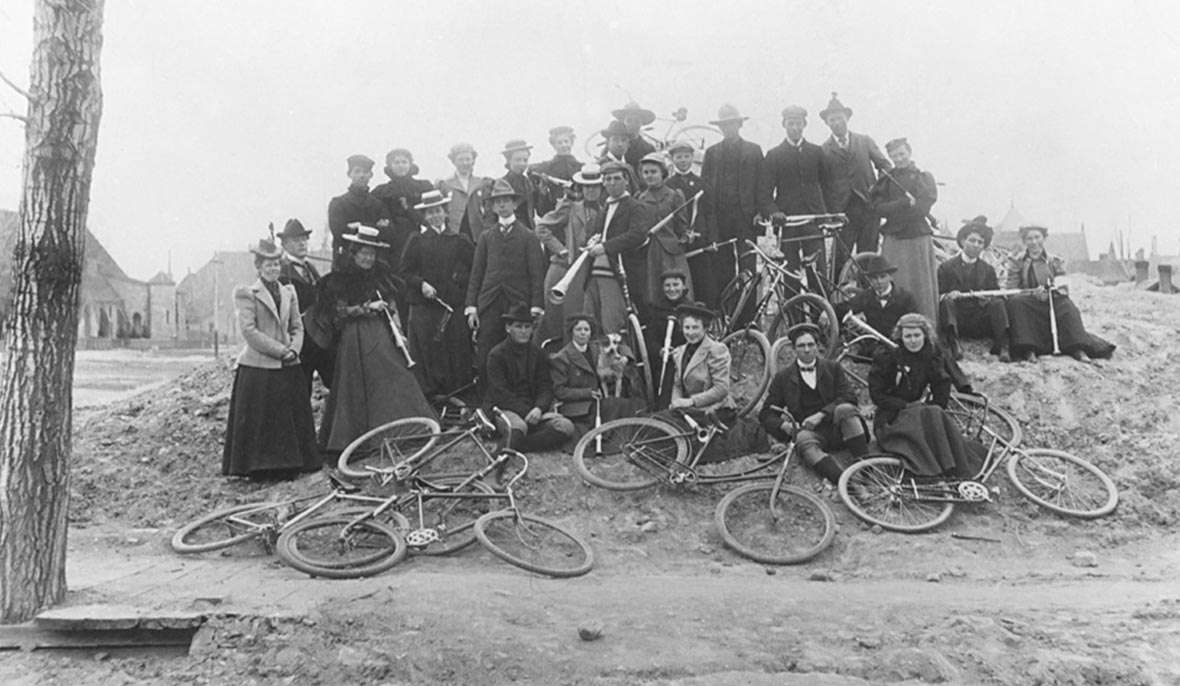
Romance and rivalry
Cheyenne journalist Daze Bristol later wrote of the romance of the era and of the rivalry between the Cheyenne clubs. She referred to the 10-mile race, the Annual Road Race of the club, which began at the Armory on Ferguson Street, looped out to Fort Russell and returned to the starting point. “One of the greatest,” she said, was the event held May 16, 1897.
One report in the Natrona County Tribune of June 3, 1897, noted that a one-mile bicycle path was being built in Cheyenne at a cost of $500. According to the newspaper, “Scorchers will be in their glory when the path is finished, but woe unto the novice.”
Daze Bristol also recalled the moonlight ride of Aug. 18, 1897, enjoyed by 26 young people and their chaperons. Clouds obscured the moon and a downpour caused the riders to make an unplanned overnight stay at their destination, Hirsig’s ranch, seven miles northwest of Cheyenne. The boys slept in the hayloft. Everyone went home the next morning.
In 1898, the Cheyenne Bicycle Club disbanded, largely because many of its members left the city to serve in the Spanish-American War.
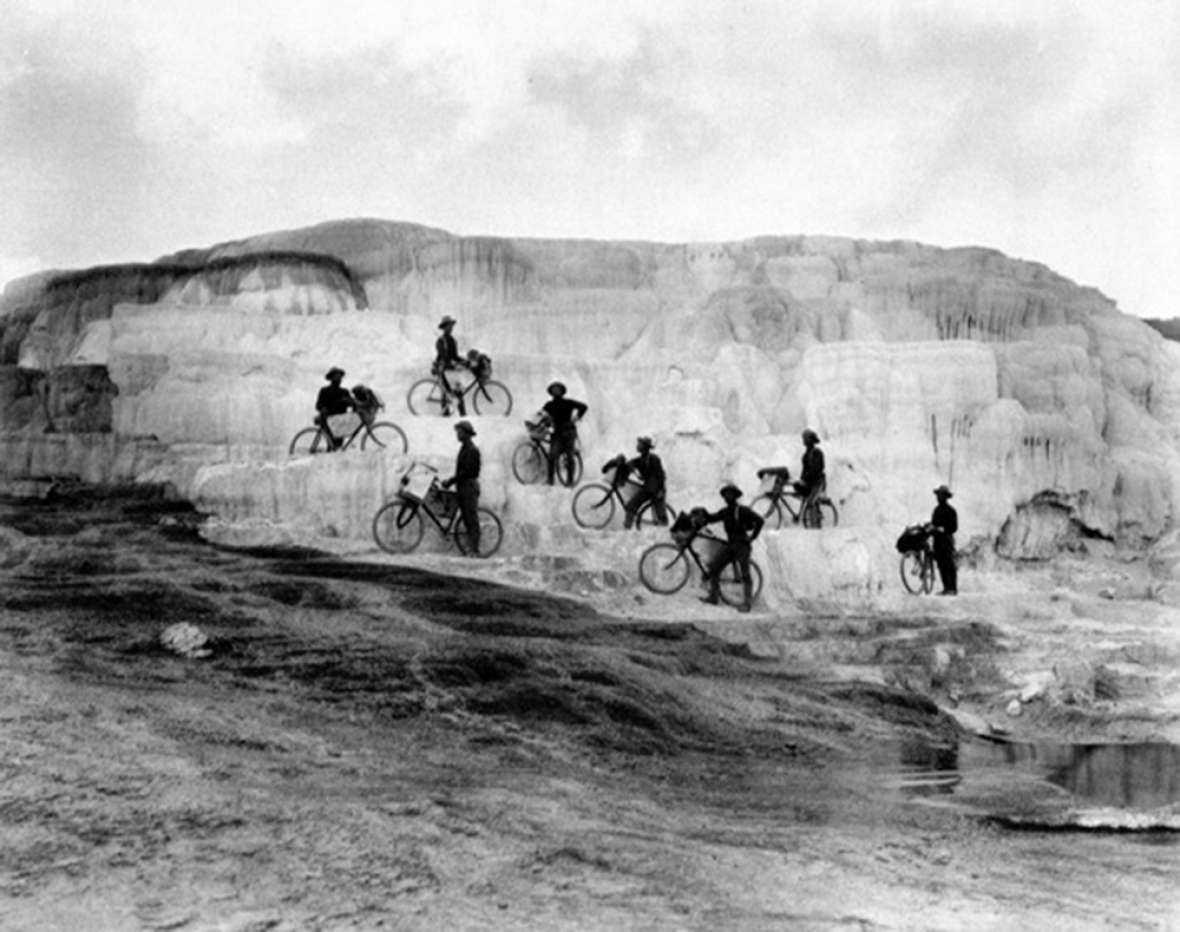
The Black Bicycle Corps
Also in 1897, the U.S. Army conducted an experiment to find out if bicycles could be an effective method of military transportation. The 25th Infantry Bicycle Corps, organized the year before in Fort Missoula, Mont., trained in Montana and in Yellowstone National Park before embarking on a 1,900-mile trip from the fort to St. Louis, Mo., on June 14, 1897, according to author Kay Moore.
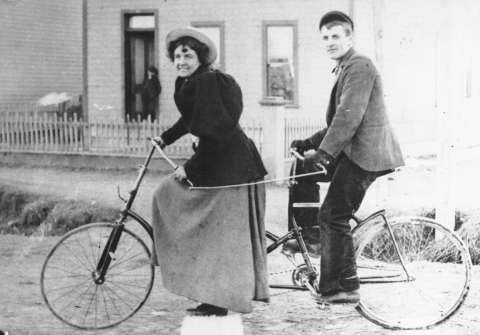
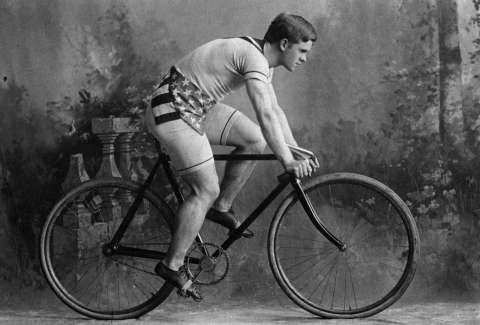
The 25th was, except for its officers, an all-black regiment—buffalo soldiers. Twenty men chosen for the duty rode steel-framed bicycles built by the Spalding Bicycle Company and tested eight different tire brands during their travels. They became known as the Black Bicycle Corps. The Montana-to-Missouri route included 233 miles across northeastern Wyoming, roughly along the Burlington Railroad line through Sheridan, Gillette and Moorcroft. They arrived in St. Louis on July 24. A permanent bicycle corps was never established by the military.
Tandems, TR and Tom Horn
Bicycle popularity continued to rise, and to become part of Wyoming’s cowboy culture. They could be expensive, and the fact that people were willing to pay high prices was testimony to their appeal. The Platte Valley Lyre in Saratoga carried an advertisement in August 1898 from the National Sewing Machine Company showing two different models of bicycles for sale; one cost $50 and the other was $40—roughly a month’s wages at the time for a top hand on a ranch. In the early 1900s, Cowboy Bicycle Races became one of the events at Cheyenne Frontier Days.
Other advancements in bicycle design included tandems—bicycles that two people could ride with separate seats, one in front of the other. Daze Bristol married Wyoming wheelman Charles Bristol in 1900. In 1903, when President Theodore Roosevelt visited Cheyenne, a special barbecue was held in his honor at U.S. Sen. Francis E. Warren’s Terry Ranch, several miles south of Cheyenne, and guests were asked to ride horseback to the event. The president rode his new mount, Wyoming, presented to him that day. Daze and Charles didn’t own any horses nor did they have money to rent a carriage. Instead, they rented a tandem bicycle and rode to the ranch. They arrived just as most of the others were leaving, met the president, missed the barbecue and biked all the way home.
In November 1902, famed stock detective Tom Horn was tried and convicted of the murder early that year of young Willie Nickell. Horn’s case was still on appeal when he and another prisoner, Jim McCloud, escaped from jail in downtown Cheyenne about 8 a.m. on August 9, 1903. Horn was on foot. McCloud took the sheriff's horse and they split up. But word of the escape “spread like wildfire,” according to the Wyoming Tribune. Hearing shots and noise, local residents hurried to the scene—a great many of them, apparently, on bicycles.
Both men were soon captured and returned to jail. Reports appeared on page 1 of the Wyoming Tribune and the Cheyenne Daily Leader the next day, with estimates of the size of the crowd ranging between hundreds and thousands. Bicycles weren’t mentioned in the reports, but a photo survives of a crowd of cyclists, walking their bikes along a street with Horn at their center, in custody. He was hanged for the crime on Nov. 20, 1903.
Modern times
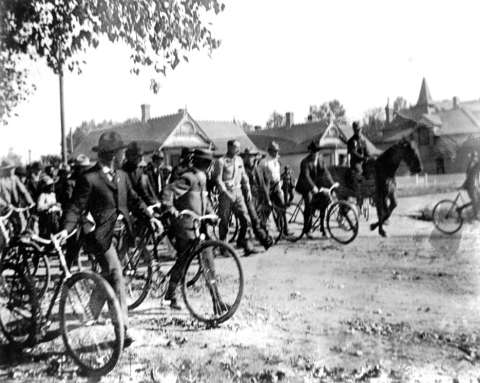
Modern day riders have participated in events ranging from the Casper Classic, which began in the 1980s, to the more recent Snowy Range Duathlon, which debuted in August 2015 at Kennaday Peak near Saratoga, Wyo., and included biking, hiking and running segments.
Destination-oriented routes allow cyclists to participate in a variety of cross-country journeys including the 2,745-mile Great Mountain Divide Bike Route from Canada to New Mexico, which runs through the Wyoming towns of Pinedale and Rawlins as well as through Grand Teton and Yellowstone national parks, or the Adventure Cycling Association’s TransAmerica Trail from Astoria, Ore., to Yorkton, Va., which also includes the two national parks and the town of Rawlins, Wyo. The Bureau of Land Management field office in Rawlins provides information on shorter tours that last from one hour to all day in the area near that town as well.
Wheelman Billy Owen wrote of the “toil and hardships” of making his pioneering trip in Yellowstone Park, but he recalled also “the pleasure and friendship of those whose welcome made our home where night o’ertook us, and left a green spot in our memory that time cannot efface.” Contemporary cyclists who pedal around Wyoming can likely relate to Owens’ sentiments, whether they ride for leisure or in competitions.
Resources
- Beaver, Robin. “Dr. Lillian Heath Nelson, Medicine Woman.” Made in Wyoming: Our Legacy of Success. Accessed Aug. 24, 2015, at http://www.madeinwyoming.net/profiles/nelson.php.
- Bristol, Daze. “When the Wheels Were King.” Wyoming State Tribune, July 22-24, 1969, D-33.
- Carlson, Chip. “Tom Horn: Wyoming Enigma.” WyoHistory.org. Accessed Aug. 24, 2015, at /essays/tom-horn.
- “Cheyenne Once Had Bike Club of National Renown,” Wyoming Eagle, Jan. 29, 1932.
- “End of the Relay Race,” San Francisco Call, Sept. 8, 1896. California Digital Newspaper Collection. Accessed Aug. 17, 2015, at http://cdnc.ucr.edu/cgi-bin/cdnc?a=d&d=SFC18960908.2.5#.
- “Great Divide Mountain Bike Route.” Wikipedia. Accessed Aug. 19, 2015, at https://en.wikipedia.org/wiki/Great_Divide_Mountain_Bike_Route.
- “Mountain Bike Trails.” U.S. Department of the Interior, Bureau of Land Management, Rawlins Field Office. Accessed Aug. 19, 2015, at http://www.blm.gov/wy/st/en/field_offices/Rawlins/rec/mtnbike.html.
- Moore, Kay. The Great Bicycle Experiment: The Army’s Historic Black Bicycle Corps, 1896-1897. Missoula, Mont.: Mountain Press Publishing Company, 2012.
- Nelson, Elmer “Kim.” “Aunt Norn and Uncle Will: Memories of the Downey Family of Laramie.” Annals of Wyoming 69 no. 1 (Winter 1997): 35-42. Accessed Aug. 21, 2105, at https://archive.org/stream/annalsofwyom69141997wyom#page/n5/mode/2up.
- Owen, W.O. “The First Bicycle Tour of the Yellowstone National Park.” Outing 18, no. 3 (June 1891): 191-195. Accessed Aug. 24, 2015, at http://babel.hathitrust.org/cgi/pt?id=mdp.39015070320380;view=1up;seq=8.
- “Packet Has Gone,” The [Wyoming] Tribune, Sept. 1, 1896.
- “Penny-farthing.” Wikipedia. Accessed Aug. 24, 2015, at https://en.wikipedia.org/wiki/Penny-farthing.
- Rea, Tom. A Kid in Hell on Wheels: Laramie as the Railroad Arrived. WyoHistory.org. Accessed Aug. 21, 2015, at /essays/kid-hell-wheels-laramie-railroad-arrived.
- “Ready in Wyoming,” New York Journal. Aug. 28, 1896.
- Rodale, Maya. “How a 175-Year-Old Woman Taught Me to Ride a Bike,” Bicycling, April 13, 2015. Accessed Aug. 6, 2015, at http://www.bicycling.com/featured-stories/how-175-year-old-woman-taught-me-ride-bicycle.
- Stone, Eileen Hallet. “Living History: The Great Bicycle Race of 1896 Just Missed Salt Lake City.” Salt Lake Tribune, May 23, 2015. Accessed Aug. 17, 2015, at http://www.sltrib.com/news/2542733-155/living-history-the-great-bicycle-race.
- “The Prize List,” Cheyenne Daily Sun, July 1, 1893, 3.
- The Yellow Fellow, Sept. 14, 1896.
- “Tom Horn, the Man Who Hanged Himself.” Wyoming Mercantile and the Book Ranch. Accessed Aug. 21, 2015, at http://www.wyomerc.com/essays/TomHorn.html.
- “TransAmerica Trail.” Adventure Cycling Association. Accessed Aug. 19, 2015, at http://www.adventurecycling.org/routes-and-maps/adventure-cycling-route-network/transamerica-trail/.
- Van Pelt, Lori. Capital Characters of Old Cheyenne. Glendo, Wyo.: High Plains Press, 2006, 234-241.
- ___________. Dreamers and Schemers: Profiles of Carbon County, Wyoming’s Past. Glendo,Wyo.: High Plains Press, 1999, 179-186.
- ___________. “Wyoming’s First Female Physician Packed a Pistol.” WyoHistory.org. Accessed Aug. 24, 2015, at /encyclopedia/lillian-heath.
- Weiss, Madeline. “Bikes to Boots on the Range,” Saratoga Sun. Accessed Aug. 17, 2015, at http://www.saratogasun.com/story/2015/08/12/lifestyles/bikes-to-boots-on-the-range/4306.html.
- Wyoming Newspaper Project. Cheyenne Daily Sun, Jan. 2, 1894, 3, and June 18, 1894, 3; Daily Boomerang, Jan. 22, 1894; Natrona County Tribune, June 3, 1897, Platte Valley Lyre, Aug. 18, 1898, and various issues of Cheyenne Daily Sun, Cheyenne Leader, Carbon County Journal and Saratoga Sun, 1869-1898. Accessed throughout August 2015 at http://www.newspapers.wyo.gov. Reports of Tom Horn’s escape ran on the front pages of the Wyoming Tribune and the Cheyenne Daily Leader on Aug. 10, 1903.
Illustrations
- The photo of the buffalo soldiers and their bicycles at Mammoth Hot Springs is from the National Park Service. Used with thanks.
- The 1897 photo of the Cheyenne Bicycle club and the photo of Tom Horn and the bicyclists are from the Wyoming State Archives. Used with permission and thanks.
- The other four photos are from the American Heritage Center. The photo of Jacob Schwoob is from the J.M. Schwoob papers, the photos of the Lovejoys and of the bicycling club at Red Buttes Station are from the Elmer F. Lovejoy papers and the 1887 photo of the three cyclists on their penny-farthings is from the Wyoming-Laramie-Clubs photo file. All are used with permission and thanks.
